#greg wyshynski
Explore tagged Tumblr posts
Text








sasha: well you see, gus is PERFECT, so jot that down — gus: 🧍♂️
#aleksander barkov#sasha barkov#gustav forsling#gus forsling#florida panthers#panthers#nhl#nhledit#hockey#hockeyedit#meg.cats#meg.gif#meg.all#scp24#this was a media availability for me specifically#pomo told me himself!!#i think probably the best thing about the playoffs#is that they make players sit side by side and compliment each other in front of god and greg wyshynski#also :( sasha always makes himself look so small when he's sitting at the podium :(((( i love him#also gustav's little smile. showing his teefies. what if i cry man i'm not god's strongest soldier!
162 notes
·
View notes
Text
so much of being a sports fan is just having intense one-sided beef with a random journalist
2K notes
·
View notes
Text



Berkelium — Connor McDavid
Berkelium is a synthetic chemical element; it has symbol Bk and atomic number 97. All berkelium isotopes have a half-life far too short to be primordial. Therefore, any primordial berkelium − that is, berkelium present on the Earth during its formation − has decayed by now.
for @simmyfrobby's nhl periodic table poetry series [ib]
click for better quality!
#connor mcdavid#edmonton oilers#oilers lb#gifs*#nhl periodic table poems#dt: wikipedia and greg wyshynski i really cant lie#super super fun ik the rules were 4 hope it still counts
45 notes
·
View notes
Text





43 unaffected by the torch spewing hot ash onto your fingers, the weight of legacy. there is a list of demands on your front door and every day it grows longer and longer. martin luther, tear down your walls.
Luke Hughes, 2022-23 NJD // the kingdom is being rebuilt.
Photo credits, in order: Nick Wass, Nick Wass, Scott Taetsch, Adam Hunger, Greg Wyshynski.
#redeye on a friday#luke hughes#nj devils#new jersey devils#hockey+poetry#the kingdom is being rebuilt: a collection of flash poetry#the words are mine! the pictures are not!#sterepoetry
56 notes
·
View notes
Text
Autumn Hockey Diaries - Defencemen, Hockey Blinders, and the Hand of the Narrative: Brock Faber In 2 Minutes and 9 Seconds
[Foreword: This essay is not what I thought it would be. It's probably not what you think it will be either. I've cut down a lot of the content because it was approaching thesis length, and I've got a lot of uni-related writing to get through. Appendices of cut content and extra reading will be published some time down the road. Look for #puckmortems.]
Brock Faber is not on the agenda. Brock Faber is a gliding figure in the middle of my screen, on occasion. More often, he is a hunched over body on the blue line, or he’s directing traffic behind the net, or he’s a blurry smear of green-red-white on the outer edges of where the play is happening. Nonetheless, it's like he’s never off the ice. “how do i even begin to write about a rookie” I say into the void in a despondent blog post, not long after I reluctantly accept that the itch won’t leave until I do. This is deeply inconvenient. I’m already in the middle of researching for another piece, halfway through an ice hockey book which I picked up in an attempt to familiarise myself with forward cycling and forechecking systems. Ironically, I have the Flyers vs Wild game up to watch an entirely different 21-year-old defenceman. My eyes snag on Faber anyway.
Let’s rewind a bit.
HOW DID I GET HERE?
Those following along already know this, but I’ve been meaning to write about the Anaheim Ducks. They caught my eye in December 2023, not long after I plunged heart-first into hockey — and then, of course, the Drysdale-Gauthier trade happened in January, and the idle research project I had going on kicked into high gear. I began to dig and dig and found narrative after narrative, and as I tried to sift through sensationalised click-farming and journalism, I felt the other narrative, capital ‘n’ Narrative, begin to close in. I was out of my depth; the rebuild was an abyss, Drysdale was inextricably linked to the media’s whipping boy, Trevor Zegras, and I was a little too fond of the Ducks to be any more lax with my research.
I wanted terribly to have clips and analysis on hand, real proof to throw in peoples’ faces when they made assumptions. There was too much to say, and too much tape to watch, and far too many books I needed to read in order to have the correct language and technical knowledge to do that kind of piece justice. I resigned myself to becoming one of those guys drawing over gameplay with a virtual marker one day. Afterwards, I picked up Take Your Eye Off the Puck: How to Watch Hockey by Knowing Where to Look by Greg Wyshynski. Unsolicited review: it’s got relevant information but all of that is sandwiched between unfunny Xennial sarcasm and Harry Potter references that are transparently desperate attempts at being accessible/relatable/fun — save your money unless you can hold your nose about all of the above. The man himself is possibly the worst thing you can be as a human being: annoying on Twitter. Any quoting from his book that I do is purely because, on occasion, he has anecdotes to share that can’t be found elsewhere.
So there I am, days out from the fallout of January 8th and rewatching Drysdale's first match.
WHO IS NUMBER 7? THE CALDER RACE, AND HOCKEY BLINDERS
But Brock Faber, number 7 a beacon on his back, surefooted and scanning the ice like a centre, is always just there. He’s skating every other shift, he’s on the penalty kill, or controlling the gap on a Flyer forward, he’s somehow also anchoring the power play — and really who is this guy? His name sounds familiar. The usual skim of articles turns up hype and speculation, opinion pieces written after Connor Bedard was confirmed to be out for 6 weeks with a broken jaw. They float Faber as a possible Calder contender, should Bedard somehow fail to catch up after his recovery.
And that’s where I’ve heard Faber’s name. He’s part of the class of poor bastards who have to share their debut season with Bedard, the fourth-coming of Gretzky — similar to Bedard’s draft year, yet infinitely worse because it’s the goddamn NHL and being in a different draft class doesn’t do you any good if you’ve got to share actual ice with him. All are afterthoughts, are footnotes in Bedard’s wake. When you speak of the rookies of the 2023-24 season the spectre of the Next Next Next One looms, and you can’t help but let slip the pity you nurse for those who would be the sweethearts of national media coverage, the new wave, if not for that monstrous boy and his, at the time, 33 points in 39 games.
There’s a border here. I step around it tenderly — helped along by a heavy dose of cognitive dissonance — when watching ice hockey, it isn’t to be crossed. I call them my ‘ice hockey horse blinders’, hockey blinders for short. They’re required safety equipment at this point, mandatory so that my sanity stays intact against everything ice hockey can be (aside from the best sport in the world): the retributive justice, the implications behind calling a player ‘soft’ for daring to protect themselves in a scrum; the insular masculist locker room culture which, in the end, is built upon rituals and language that degrades women and positions queerness as lesser-than.
One must also avoid thinking too hard about the way players are bandied about and dealt with like livestock, the way that they’re workers who sell their labour, too, and how they only really get to self-advocate when the collective bargaining agreement rolls around; how even then they’re hampered by all these unspoken traditions, arbitrary codes. Breathe and forget for a moment, for at least sixty glorious minutes of skating and violence, that for any athlete — for any prodigy — to exist and thrive, a child’s life was appropriated, taken in hand and moulded to fit a pipeline of production, because sports is a business the exact same way music and movies are.
The more I learn about Brock Faber, the harder it is to keep the hockey blinders from slipping off.
“Brock Faber shouldn’t be possible,” is what people write about him in one form or another. They marvel at his strength, his size, his resilience; release article after article about how another rookie d-man would likely buckle under the weight of the work, how none of this was ever expected from someone so young and untested. Yet, the longer I sit with it the more unsettled I am. I watch his time on ice tick up and up with each game, hear on broadcast and read online that he’s on track to break the record for rookie average TOI. As of writing, he’s got 430 minutes on his next teammate for total time on ice. The only players on the Wild ahead of him are their goalies. The longer I put off finishing this essay (months now, from the time I first committed words to document) the wider this gap will grow. They say no one ever expected this from him, but an insidious thought creeps in: hasn’t the Narrative demanded this all along?
TIME, HAUNTING, AND MINNESOTA
Turns out I wasn’t wrong about Faber’s presence on the ice. The Wild have him skating minutes that usually go to veterans. He skates for 28:49 in the Philly match. Between the 10th of December and the 6th of January, Faber played 13 games. In 10 of them, he spent over 24 minutes skating. In half of those games, he logged over 30 minutes of ice time.

(NHL.com, highlights mine)
These are playoffs numbers, and they don’t just call it “playoffs hockey” because of the physicality. Exhaustion and injury go hand in hand, and playoffs hockey claims it’s tributes every year — rarely is it that this pace is sustainable, evidenced by how no teams make it through playoffs completely healthy. Top d-men are capable of it, yes, but it’s best avoided. When it happens, it’s an aberration. Poor management of ice time can result in sloppy play due to exhaustion. For the player who is exhausted, who fears exhaustion at critical junctures, they may choose to limit themselves, to compromise on plays to preserve their energy. More salient: every surplus minute extends the timeframe for possible injury, and every additional responsibility piled on top of that opens the door to potential burnout. So why do that to a rookie? What would compel any coach to do this, considering the risks?
Is Faber that good?
The question warrants another step backwards. Trouble is, this is where the tape begins to skip, a reverb-stutter-reverse that’s impossible to ignore. How far back to go? Does it start with the injuries that gutted the Wild’s d-core, shifting Faber into the limelight for sheer lack of options? Maybe further? Maybe it began in the mere hours between when Faber lost a devastating final match with his college team and signing with the Wild to play his very first NHL games — the third of which was the fucking Stanley Cup playoffs.
Or perhaps it kicked off with the Wild buying out the Parise and Suter contracts in an effort to purge the team’s culture and start afresh? This was Wild management signalling that they’d take the salary cap penalty for now, but they were banking on a significant cap rise in the coming years. The subsequent “devastation” when Gary Bettman announced that the salary cap would only be going up by 1 million the following season — guaranteeing the Wild’s next few years would be lean ones — is what led to Faber being traded from the LA Kings for the Wild’s Kevin Fiala, after all.
But maybe linearity isn’t the play. The Narrative cannot be temporally bound, so why should this essay? The weft and warp of the Narrative sprawls out in four dimensions: the present weaves itself into the past; futures that never were dig their way down into the seams of time to rip into the present; and history is a concertina of repetitions and echoes, the same threads again and again.
Time and history are a deep well, I hover and put my ear to the dark, and Minnesota is the sound that echoes down. Minnesota, Minnesota, Minnesota.
Minnesota, the State of Hockey — and Brock Faber is a Minnesota boy. The Gophers, his college team, are a Minnesota team. He grows up going to Minnesota Wild games. And, because no kid gets to play for the team they grew up watching, he gets drafted 45th overall by the LA Kings. That’s the business; when you play hockey you are at the mercy of the draft lottery and the end-of-season standings.



(@ mnwild via Twitter/X)
Only, this is the Narrative we’re talking about. The moment someone says ‘unlikely’ or ‘never’, it emerges and reasserts itself: sometimes things can be right out of a movie script. In Faber’s case, a dream. He talks openly about just how happy and grateful he is to be there. A real hometown hero — the title conferred upon him by media and fans and the ever-present Narrative. Faber doesn’t get to escape it just because the chances are slim, just because all the other Minnesota boys were scattered at the draft.
The Minnesota Wild as a franchise is held within its grip, too.
What do you call a Cup drought when it’s never rained in the first place? Meet the Wild, a middling American expansion team that’s not quite young enough to excuse their limping performance anymore, not quite old enough to have a sterling legacy to fall back upon. “Advancement seems there for the taking. It’s the least they could do after teasing this forsaken market April after unfulfilling April,” writes Brian Murphy; an embittered rally against the Wild’s historic floundering, even as he gushes about Faber’s first few games. Playoffs made in 13 out of 23 seasons aren't awful odds…until you read a little further to find out they’ve never come within sniffing distance of the finals. They are, it seems, perpetually on the cusp of — something. I couldn’t tell you what. Destruction? Greatness? Glory, even?

(via sergeifyodorov)
Just over 5 years ago, the front office asked for continued support in an open letter to fans. There would be a little patience required, but not too much — not when glory was just around the corner. The letter does not mention the vortex of rumours surrounding the locker room, the two veteran contracts they had to excise. They wouldn’t be rebuilding, of course, no need to panic and no need for a teardown — they had the pieces in line and were ready for a real effort, a deep run at the playoffs and a Cup, and “nothing less.”
Funny, a little over 5 years before that there was yet another letter asking for yet another small stretch of patience, right after acquiring two very familiar contracts. Parise and Suter, for those unaware, were brought in as two experienced players who would push the Wild over the line from “perennial playoff team” to Cup winners. Big name free agents, with lots of clout to go with them — and of course they chose Minnesota, says owner Craig Leipold, citing their “strong ties to the area.” Glory was, once again, just around the corner — what could go wrong?
And this time there’s been no letter but now they have Brock Faber, so bright and talented and so willing to just keep going, taking what he’s served, assignment after assignment. They have Kirill Kaprizov, a true superstar, ‘The Guy’, the kind who plants a flag and becomes the franchise. They’ve got Marco Rossi, yet another of their rookies who has made an incredible, unexpected splash — NHL-ready against the odds. The final season of the Parise-Suter buyouts will come in the next two years, and with it will arrive the much-needed relief of league-wide cap increases.And now, we see, the Narrative keeps the wheel spinning, keeps the story going in that reverb-stutter-reverse — and glory is just around the corner.
DEFENCEMEN AND THE SIZE ISSUE
Let’s talk about what it means to be a top pairing defenceman in the modern NHL. The Minnesota Wild’s d-core is fried from season-derailing (and in Jared Spurgeon’s case, ending) injury, yes. But normally, filling in wouldn’t fall to a defenceman in his rookie year. Where another team might’ve spread the responsibilities, Faber is given the lion’s share of downed d-men Brodin and Spurgeon’s duties. He's the power play quarterback, a given presence on the penalty kill; he’s out on the ice during OT; at times sent out as a catch-all shutdown defenceman versus the league’s best forwards (I watch him try to keep up with McDavid reviewing an earlier match against the Oilers and I think, with my heart in my mouth: you are so fucking young). It’s more than just a lack of options. To answer my own question: Faber might actually be that good.
I’m talking around it, but the Norris Trophy isn’t handed out to defencemen who can’t rack up points. And on the whole, defencemen who aren’t geared toward offence don’t score. The debate comes around every season now, I assume, to just make a new award for the best defensive-defenceman — this is entirely down to how the responsibilities and expectations of d-men are undergoing rapid evolution in the shadow of elite skaters and puck movers like Cale Makar and Erik Karlsson. The age of pure stay-at-home defencemen — those that play shutdown to the exclusion of all else — is seemingly winding down, has been for a while. “Offensive-defenceman” is no cute rejoinder for d-men who happen to have a little offensive upside. From Bobby Orr until now, it’s become synonymous with a set of traits that define the league’s best blueliners. Skating prowess is part of it, being able to carry and protect the puck is part of it, but the best of the best are able to seamlessly transition from defence to offence, joining the rush from the d-zone after a turnover, to become lethal in the slot.
Where Brock Faber lands on all these metrics begins with who he was before he arrived in the NHL. He makes a strange case amongst all the rookie defencemen I’ve had the chance to research, a mixing pot of what’s usually found desirable in a prospect — and a few quirks that separate him from the pack. I was shocked when I found out Faber played an exclusively defensive role for the Gophers right up until he signed with the Wild — and before then had spent no time on the power play. “I just hated getting scored on by these kids in college,” says Faber in his interview on the Wild’s official team podcast [43:31]. He goes on to tell the hosts; it actually feels easier to play in the NHL at times, because his teammates know where they’re supposed to be, and if he pushes up on an opportunity he can trust someone else to drop back and fill that gap — he is certain that this has smoothed the bumps in his offensive leap forward. And how has he done? Incredibly, by all accounts. Of the many scouting videos, podcasts, and articles I’ve perused, this trajectory is… rare. At least, for top defenceman prospects. He’s got it all backwards, see; as opposed to the archetype of the puck-moving, dynamic attacker who has leaks in their defensive game (presumably, something that must be worked on as they come into their own in the NHL), he came in a defensive powerhouse, a shutdown-d, and had to learn to let go of the blue line and attack. It took two months for the Wild to ease him into taking on Spurgeon’s role as PP1 quarterback, but since then he’s been a standout player.
Past the power play, Faber’s point and goal production has skyrocketed in comparison to his pre-NHL career — seemingly out of nowhere. He’s got the skating and the stick handling ability to do it, and now it seems he’s begun to hone that killer instinct. Coach Evason, before his dismissal, let out a critique of a then-struggling Wild: "Brock Faber can't be our best player every night.” On a streaky, at times unstoppable, at times paper-thin Wild defence, Faber was a boon.
One very obvious way Faber has adhered to the specifications laid out by scouts is his height and weight. It’s said that defencemen take a little longer than forwards to start showing up in the NHL from the time they’re drafted. It’s the body-size issue, according to some. The d-men who make the cut are older, bigger. The myth goes: while rookie forwards might get away with being 5 '9’’ and underweight on account of agility and hockey sense (and more than a little help from coaches who send them out while the puck is in the o-zone), when you’re a blueliner, and hence the only thing standing between Auston Matthews’ finisher, Nathan MacKinnon's rush, and a clear shot on your goalie and the back of the net, you can’t afford to be small.
We’re living in a post-Statistical Analysis Revolution hockey world, though, so we know a little better about size. An alternative explanation to the size myth is something I’ve only ever heard of in oblique references — specific to d-men, coaches call it the “200 game” threshold for development. Further inquiry, (including appropriation of university catalogue access and trawling JSTOR), has turned up little helpful literature on the origins of this belief, aside from a stub of an article that called the cutoff “artificial”, taking note that prospects who failed to perform to standards by the 200-game mark were written off as doomed AHL ‘tweeners. I did, however, find a very interesting statistical analysis write-up by the folks over at Dobber Hockey.
Undersized forwards don’t float through on skill and quickness alone; one of the biggest predictors for success is, according to Dobber and Mat Porter, falling within the league average for size and weight. The theory here has been dubbed BT, short for “breakout threshold”, and represents the number of games taken for any given player to become competent and start producing consistently in the NHL. That number, for the average player? 200 games. And contrary to stereotypes, undersized defencemen and forwards struggle. Furthermore, a stat that defies intuition arises when examining those on the taller end. Data doesn’t lie: “Bigger defencemen and exceptionally-sized forwards need 400 NHL regular season games.” Porter posits that growth spurts can be a detriment to young players just entering the NHL; the jump in body mass causing a mismatch in their expectations of their bodies, a “simple physics” problem, necessitating a slight buffering period as they readjust their physical and spatial awareness around the changes.
The belief remains, however, that larger is better. I’m understating just how much it pervades hockey discourses. It’s present in scouting reports and has had measurable impacts on drafting; I hear it on hockey podcasts; it’s thrown out casually during interviews by coaches and fellow players; it's the first thing you'll hear from a caster who isn't familiar with a player's game. I can’t read or listen to anything about Faber without stumbling across it — the preoccupation with size.
The language used to praise Faber and players like him has my stomach twisting in a discomfort that I find hard to quantify — players, coaches, and the media all talk about him, and the hockey blinders slip. He’s a “workhorse”, a “stud”, he’s got “a man’s body” — and call it projecting, call it reading too deeply into innocuous statements, but the closest thing I can compare it to is hearing my AFAB body spoken about as an object whose value can be reduced to its function, its usefulness, its closeness to sexual maturity.
Elite athleticism is produced when you derail a child’s life and set them on the path, just the same as all the other entertainment industries — think: the k-pop idol machine, pageants, child actors and models who then become adult celebrities, and, of course, the emerging phenomenon of the child influencer. For men’s sports, there’s something extra on top of the commodification of children’s bodies — it’s the vernacular of near-fetishistic worship; of the masculine, the oxymoronic youthful-but-mature, the virile.
I’ll be very clear here: I’m not reading anything malicious from specific people, I’m not accusing anyone of crimes, and in no way am I implying that ice hockey is unique here. Just the opposite, in fact. I know professional sports hinges upon producing stars, that the commodification of young bodies is endemic to the business. Those stars are, stripped down to the basest definition, workers who perform with their bodies and sell their labour, whose bodies will inevitably be coveted and revered for their adherence to the Platonic ideal of their respective crafts. MYTHMAKING: THE SHIFT
“Brock Faber’s play in overtime of the Minnesota Wild’s Dec. 14 victory over Calgary almost certainly has been long forgotten,” says Judd Zulgad in yet another article covering the miracle of Faber’s rookie season. Zulgad is wrong. This overtime play has been repeated, over and over again, a new myth constructed around Faber before our eyes. “He’s completely exhausted, but not only [gave] a second effort, he’s got the wherewithal to bump the puck back so we can gain possession and get a line change,” says Wild coach John Hynes — this particular quote is a favourite for the beat writers who mill out post-game fluff pieces.
The overtime starts like any other: face-off at centre ice, 3-on-3. The broadcast takes note that Brock Faber is starting, that he’s developed offensively in his rookie season. Things fall apart not long after.
Overtime line changes are tricky business. The margins for error are razor thin with 3-on-3; a sloppy line change during OT is a free odd-man rush for the opposing team. Almost guaranteed instant annihilation, and a pretty rude thing to put your goalie through to boot. You must, must clear the puck from your zone before changing over. This is how Brock Faber ends up on the ice; trapped with the puck in the Wild’s d-zone for 2 minutes and 9 seconds.
Time trickles on as he engages in a scrap along the boards. The broadcast takes note of just how long he’s been on the ice around the time that I do, and then he stumbles. And what you’ve got to understand about Brock Faber is that the comments about his poise aren’t for nothing: Faber doesn’t fall, he doesn’t lose his edges. His skating, his balance, his ability to leverage his reach — is elite.
He takes a knee after the play moves away, slow to get up. The casters say what we’re all thinking as he skates back to the safety of the bench: “he’s running on fumes.” How can anyone watch this and feel anything other than sorry? He is barely there. He is carved down to the marrow, and all that made him wonderful to witness — his beautiful skating, his steadiness, his mastery of the craft — is cut away by exhaustion. Watching him tip over, watching his desperate last-second handling of the puck — it feels less heroic every time. I replay the overtime again and again to write this section and I ache. I am with him out there, losing my feet and my breath just the same.
When he makes it back to the bench, finally, there is no relief. The cameras voyeuristically linger on his pale, worn face, his eyes sweat-stung, as he slams his stick against the boards, each hit shuddering through his body. I want to take it from his hands. I want to wipe his brow and tell him he can rest, rest, rest. Later, giving an interview, instead of taking up the accolades he’s recounting how his turnover led to that endless overtime stretch. He is, of course, not wrong. But he’s not seeing the larger picture.
Consider: this is the kid who grew up watching the Minnesota Wild fail year after year, who likely held a secret hope that they’d draft him when it was his day — this Minnesota boy and his home-grown, Minnesota heart. He never once thought of himself as separate from Minnesota, because this is home, this is where his hockey dream was born; and this is where it must, to him, be fulfilled — of course he’d take on everything they ever asked, swallow down his duties and only ever be grateful.
There is no other way this could’ve gone.
THE HAND OF THE NARRATIVE
I'm trying to love ice hockey with my eyes open. If you haven't figured it out by now, my writing is rarely just about players or hockey concepts. It's about me - these posts are essentially a diary I've chosen to publish. Recently, I had a lecturer read this essay. She commented that it read like someone trying to come to terms with loving hockey. She was right.
"It would be just like the Minnesota Wild to carry on with their perennial early playoffs exits." That's how this paragraph started, when I was first drafting this piece. I'll be transparent; I believe in the potential of this team, and I want them to make an honest effort to win the Cup - but I need it to happen some other time. Armchair GM/coach moment: they aren't ready. They didn't feel ready to me, with their captain out and a rookie d-man holding their blue line together, and injury after injury piling on as the season entered its last weeks. I saw them pushing for another run at the Cup, saw their continued use of Faber in all situations, and thought, ah - see you in another five years. Wanting it simply isn't enough. And Brock Faber, as good as he is, cannot sustain this team on myth. No one person can.
I started this essay terrified Faber would get injured from over-use and play through it for the sake of the postseason, like so many players do; or that he would hit the infamous 'rookie wall' and flame out in his development (in the back of my mind, the question is still there). A few days ago, the Minnesota Wild were mathematically eliminated from playoffs contention. I breathed a little easier. I liked this team too fucking much to see them suffer. I wrote this essay with a kind of despair over Wild management and their preoccupation with Win-Now at the cost of the future. I wondered if Kirill Kaprizov's prime would run its course with the Wild barely scratching the surface of a playoffs run year after year. I wondered at times if the hand of the Narrative would intervene and make it so. The Minnesota Wild are haunted like that.
There are pages worth of writing to add to this essay that I've cut for brevity, and for the sake of telling Brock Faber's story in a way where it wouldn't be obscured by it.
I considered talking about my athlete friends. I spoke to them, informal interviews, we talked about the kind of mentality instilled in children who dream of going pro. You never say 'no'. You love your sport, you let it turn you inside out, you would do anything to keep going. Most of all, you think I'm still young. I can play through this pain. And once you aren't young anymore, you think I'm not young anymore. I'm running out of time. I have to play through this pain. And when your best years are behind you, your ideas about your body and your health are so twisted that you will grind the cartilage in your knees away to make the jump, you will play yourself into irreparable nerve damage just to be remembered, just to have the chance to touch greatness.
This is the truncated version. This is what I fear most when I think of the crushing weight of the Narrative upon someone like Brock Faber. He's hardly the first young athlete to be put in this position, he won't be the last. This essay is about him in the loosest sense that I'm covering the beats of his career and his team. It's not about him at all in the sense that it's about me and my crisis of faith.
To break character: I've been talking about the Narrative with a capital 'n', as though it is an entity with a will of its own. Sometimes it feels that way. It's not, and it doesn't, and it feels that way because we care so much. The hand of the Narrative is just how I rationalise the coincidences, the eerie parallels, the compelling threads of story that exist in sports.
I've wrestled with how to conclude this piece for months now. Since I started writing, I've taken up sports photography, produced poems and essays and assignments about hockey, and I've started ice skating - and in the process I've fallen in love with my dilapidated local rink. I'm now covering the AIHL, which zero people on this website care about. A lot has changed. I still don't know how to finish this, so here are some closing thoughts:
The hand of the Narrative is as real as we make it.
My leftist ennui about professional sports under capitalism could probably be explored on another platform - in a different essay that won't be hosted here.
That thesis I'm never writing about haunting, hauntology, and hockey is probably a symptom of some greater preoccupation. (There's an unfinished manifesto sitting in my drafts.)
If you're a Wild fan reading this - sorry for the editorialising about the Minnesota Wild. I'm quiet about it, but I do love this team and I want to see them be the best version of themselves.
Brock Faber deserves the Calder. He deserved it when I first started this piece, when maybe five people were talking about it, and he deserves it now.
Despite the turmoil of the season, the disappointments, the setbacks - I am still so excited to watch this team and write about them.
I think I'm going to love hockey for a long time.
#fyi this was 12k words of like.. research about d-men and stats and prospect development#and personal anecdotes about me and my athlete friends. it is now roughly 5k.#appendices... coming soon. hiding my face in my hands. im in shambles#why does everything i write read like a confessional? oh easy. too much sylvia plath growing up#my writing#minnesota wild#brock faber#player stuff#team stuff#narrativeposting
18 notes
·
View notes
Text
Devils coach calls out Rangers' Matt Rempe -- 'intent to injure'
Matt Rempe gets called out by the Devils.
By Tristin McKinstry
Mar 12, 2024 at 12:07 AM EDT2 min read
Devils coach Travis Green calling out Rangers forward Matt Rempe.
The New Jersey Devils were not happy after their game on Monday night. New Jersey lost to the New York Rangers at Madison Square Garden, for one thing. The team also lost defenseman Jonas Siegenthaler in the game after a dangerous hit from rookie forward Matt Rempe.
Rempe received five minutes for elbowing and a game misconduct. After the game, interim Devils coach Travis Green addressed the hit from New York's rookie. Green was rather blunt with his thoughts on the hit in Monday night's contest.
Demand Better
Demand better, and if they call you unreasonable, call us.
“I think there's some intent there to injure the player,” the Devils interim coach said, via ESPN's Greg Wyshynski. “Call it predatorial or whatever you want to call it. It's definitely not the 1st time that it's happened and 2nd time against us.”
Devils' Travis Green provides update on Jonas Siegenthaler
Siegenthaler is one of the more underrated defensemen in the NHL. Though he is having a bit of a down season, he has still played an important role for the Devils for a few seasons. New Jersey is a better team with him in the lineup. However, the update on his status was not great after Monday's game.
He’s not doing great, obviously. He didn’t come back. You never like to see a player get hit like that, especially that’s happened twice now,” Green told reporters following the loss, via Devils team reporter Amanda Stein. Devils forward Kurtis MacDermid attempted to fight Matt Rempe for another hit earlier in the season. However, Rempe did not answer the bell. And his unwillingness to fight left New Jersey's interim bench boss somewhat surprised.
There is a bit of a code in the league. I was a little surprised from the beginning of the game. (MacDermid) tried to live by the code early in the game. That didn’t happen. Tried to do it then, it didn’t happen,” Green said, via Stein.
Fans of the Devils and Rangers should keep April 3rd circled on their calendars. That night, New York and New Jersey meet for the final time this season. Let's see if Travis Green and his team go after Matt Rempe once again in the final month before the playoffs.
What is your alls opinion on this
17 notes
·
View notes
Text
thinking fondly today about how good fic is at lovingly preserving little, largely inconsequential aspects of fandom culture, tiny flies in amber. this one's got a reference to greg wyshynski writing the puck daddy blog. here's a wink at deadspin's sleaze. there's a nod to the 31 thoughts podcast. maybe one day i'll be re-reading an old favourite and have a nostalgic smile about references to the athletic
#something about the way that fic's so current#about the way that sports fandom is so tied up in sports media consumption#it gives us all these hundreds of tiny snapshots of what sports fandom was like at that exact moment in time#the risings and fallings of sports media
30 notes
·
View notes
Text
greg wyshynski finding the narrative like a blind pig with a truffle

25 notes
·
View notes
Text
Ok devils fans….
I have news for you all
This is from ESPN ( I am just a fan I do not work for them)
March 8: Jets land Toffoli in deal with the Devils
The New Jersey Devils trade winger Tyler Toffoli to the Winnipeg Jets for a 2024 third-round pick and a 2025 second-round pick.
This was the second time the Jets have jumped on the "plan B" player at the deadline. They were in on Elias Lindholm before he was traded to the Vancouver Canucks, and then traded for Montreal Canadiens center Sean Monahan.
The Jets weren't one of the teams that were mentioned in the Jake Guentzel derby, but after he went to the Carolina Hurricanes on Thursday night, Toffoli became the next best option on the wing for a veteran scorer with an expiring contract. Once again, they snagged the next man up, and in doing so added a very impactful player to what's become an all-in season.
Winnipeg needed scoring on the wing, and Toffoli can provide it. The 31-year-old has 26 goals in 61 games this season for the Devils, including eight tallies on the power play. He brings 88 games of Stanley Cup Playoffs experience, including a Cup win with the Los Angeles Kings in 2014. He has 44 points in the playoffs.
One could see him sliding onto a line with Nikolaj Ehlers and Sean Monahan, giving the Jets another potent offensive trio behind the Mark Scheifele and Kyle Connor line.
It's pretty impressive that the Jets were able to land Toffoli without giving up a first-round pick in 2025 or their second-round pick this season, which belonged to the Canadiens and would have been a de facto low first-rounder.
Even more impressive: They kept Toffoli away from the rest of the competition in the Western Conference, as Vegas, Vancouver and Los Angeles were all rumored to be in the running for him.
The Jets' defensive prowess has positioned them as a serious contender in the West. In Toffoli, they've smartly bolstered their offensive group with a deadline coup who fits well into their culture.
New Jersey GM Tom Fitzgerald told me earlier this week that he wasn't shopping Toffoli, the team's leading goal-scorer. After all, they fired head coach Lindy Ruff as a Hail Mary to make the playoffs this season. Doing so without Toffoli would seem to make that a much more difficult path than it already was. In fact. Fitzgerald admitted that trading Toffoli would be seen as "throwing in the towel" on the season by his players.
But Fitzgerald was listening on Toffoli, as he should have. The Devils have a less than 10% chance of making the playoffs, per Stathletes. While the team and Toffoli had contract extension talks, they were light years apart on money and especially term -- one source indicated that New Jersey was only going as high as two years.
Did the Devils maximize the market for Toffoli? They did pretty well here, all things considered.
They retained 50% of Toffoli's salary, and got a better return than what Seattle got back for Alex Wennberg, more than Ottawa got back for Vladimir Tarasenko, and more than the Capitals got back for Anthony Mantha, despite all of those teams retaining 50% and having already set the market.
There doesn't appear to be any salary retention from the Devils here, and they still net out with a better return for a player that was no longer in their plans.
There's going to be some that look at the Devils having given up winger Yegor Sharangovich and a third-round pick for Toffoli last summer and compare that to this return. That's understandable, given that Sharangovich is a 25-year-old with 25 goals this season in Calgary. But it's not like Toffoli didn't perform for the Devils. It's just that the Devils didn't perform well enough around him, turning a team with playoff aspirations into a deadline seller. -- Greg Wyshynski
You can look it up yourselves I will leave a link for you all to look at the trade deadline
#jack hughes#new jersey devils#hockey imagine#nico hischier#luke hughes#hockey#timo meier#john marino
4 notes
·
View notes
Text
Tag 9 People You Want To Get To Know Better!
Thank you for the tag @hamburgerslippers 💞
1&2. First Ship and Three Ships: my mind went blank here, I can’t think of anything at the moment.
3. Last song: Minha Mulher Acha Que Eu Sou Brad Pitt by Nill
4. Last movie: Glass Onion, wouldn’t have watched it if not for that interview with Daniel Craig.
5. Currently reading: like 10 books at the same time?? Mainly Take Your Eye Off The Puck by Greg Wyshynski, Street Art by Simon Armstrong and The Great War And Modern Memory by Paul Fussell, but I do have a lot more to finish.
6. Currently consuming: as in physically or a hyperfixation? An avocado salad and hockey narratives respectively.
7. Currently craving: for school to finally end, that shitshow is making me sooo tired. Decaf ice latte also.
I won’t tag anyone in particular, but feel free to do it if you want to!
2 notes
·
View notes
Text
updated with the latest from the asg behind the scenes: everyone knowing nate is so possessive over sid that even nhl.com senior writer greg wyshynski is like "he'll pulverise you if you even look at his boy"

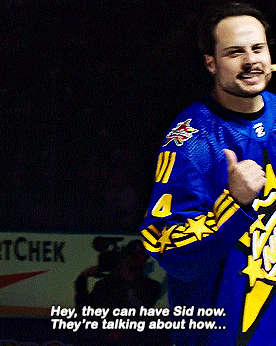
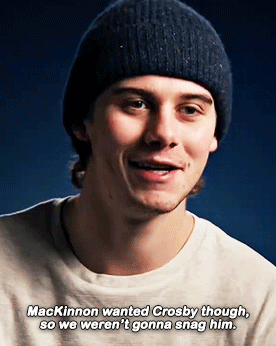


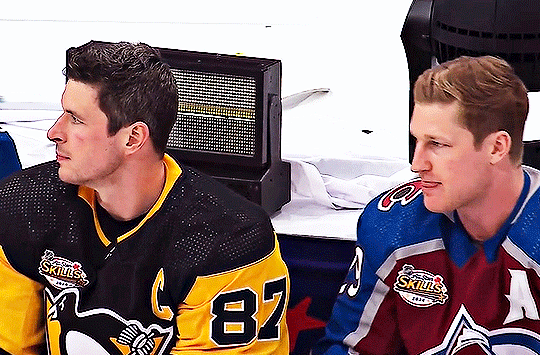
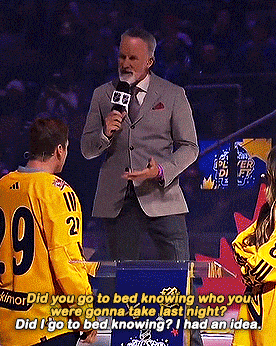
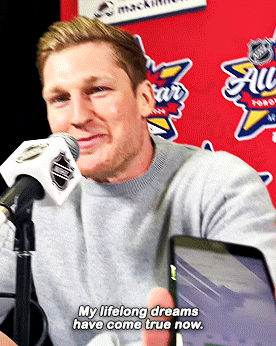
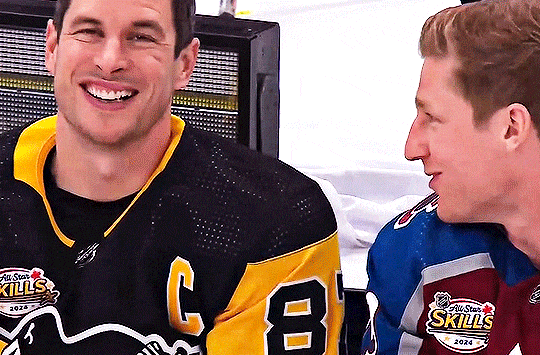



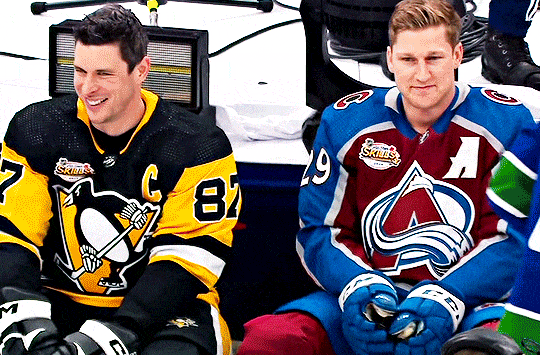




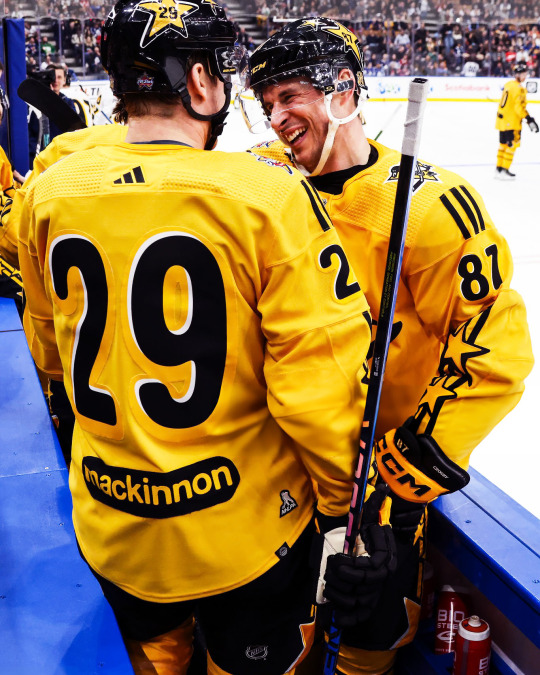

what if you were my idol turned best friend who everyone in the league knew i was completely gone for. and what if i drafted you first on the team i was captaining for the all star game after begging the captains going before me not to pick you. and what if i told reporters that this was my longtime dream come true. and what if you told them later that all you wanted to do now was to make your captain happy. and what if after all that... you put my hoodie on and did a live interview in front of god and gary bettman.
4K notes
·
View notes
Text
fake ass bitches wanna be part of what we have so badly

#WARNING: DO NOT INTERACT WITH THIS FRAUDULENT SKANK#STAY OUT OF SHARKS BUSINESS#this is a greg wyshynski hate account first and foremost#he thinks he’s one of the girls dont start your car tomorrow morning 🤣🤣🤣#sharks lb
13 notes
·
View notes
Note
https://www.tumblr.com/hockeygossipdaily/765580056246583296/httpswwwtumblrcomhockeygossipdaily7655471784
probably unrelated but this reminds me he once went as Donald trump for Halloween and lauren went as mrs. trump
https://www.espn.com/nhl/story/_/id/21230364/nhl-greg-wyshynski-connor-mcdavid-dresses-donald-trump-halloween
I didn’t know they wrote an article on it-
0 notes
Text
sheng peng with PEAK offseason content right here. all of you take notes
18 notes
·
View notes
Text

Tom Wilson and Sidney Crosby have been on opposite sides of the heated Capitals vs Penguins rivalry for a decade at this point. The two ultra-competitive NHLers don’t share much in common on the ice in terms of playing style but it turns out they do off of it.
The two revealed their shared hobby to ESPN’s Kristen Shilton and Greg Wyshynski at the recent NHL Player Media Tour.
“What’s your favorite off-day activity?”, the two Metropolitan Division foes were asked.
“I like anything outdoors,” Crosby answered. “Hiking, kayaking, fishing. Lake kayaking. I don’t mess with the ocean too much. [Laughs] I really enjoy that. It’s a good way for me to stay active, but I love being in nature, be on the water, and things like that, so if I get an opportunity to do that, it’s great.”
Tom Wilson was up next.
“Go to the dog park or go on a bit of a hike with the dog,”the Capitals winger said. “There’s some great trails in Virginia where we live so that’s always good to clear your mind.”
So, while the two can frequently be seen butting heads on the ice, it sounds like they might enjoy each other’s company off of it. The two were recently pictured being friendly with one another at the very same event where the answers to these questions were gathered.
rmnb said: maybe sidney crosby and tom wilson should go on a date

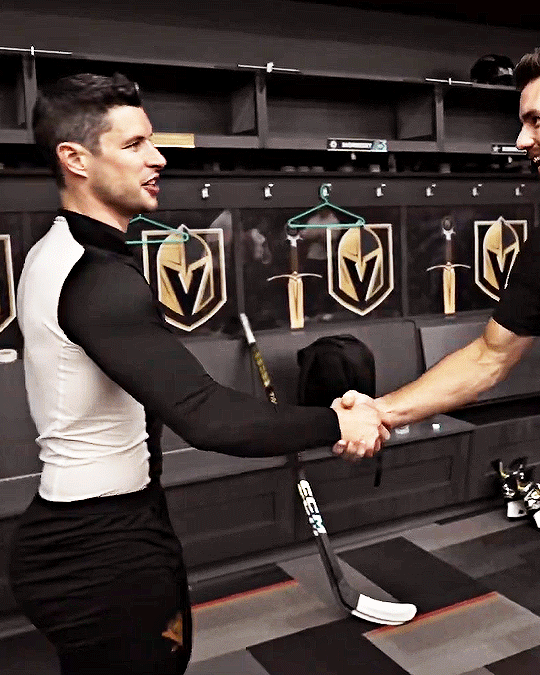

hate that, man
4K notes
·
View notes
Text
2024 NHL draft live updates: 7-round, 32-team pick tracker
The 2024 NHL draft is complete. From the first round all the way to pick No. 225 in Round 7, this page is your home for every selection, including scouting notes from Rachel Doerrie, and team fit analysis for the 32 players taken in the first round from Ryan S. Clark and Greg Wyshynski. More: Grades for all 32Winners and losersProfiles: CelebriniTij Iginla Team: Boston University (H-EAST) |…

View On WordPress
0 notes